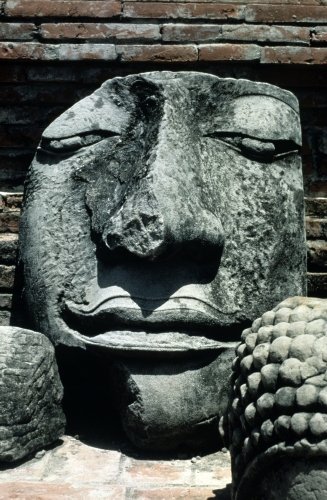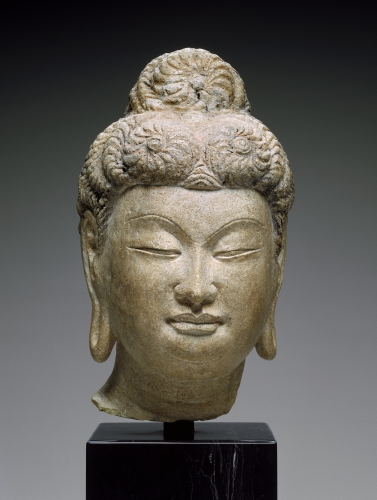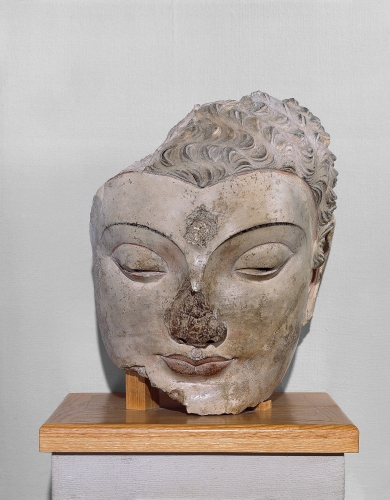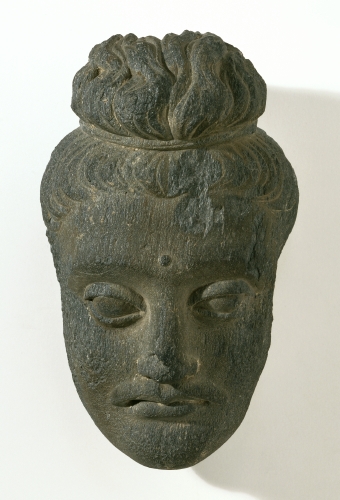Smile of the Buddha in Art
The look on the Buddha’s face of serenity is probably what some of us acquired after having a three-day weekend for Labor Day. But, this image intrigued me because—as is the case with every religion on the planet that produces images of their deity, from one culture to the next—the differences in style are simply fascinating. The historical dates for the Buddha are ca. 563–483 BCE.
 |
| Thailand, Ayutthaya, Fragmentary colossal Head of the Buddha, from the temple precinct of Wat Phra Mahathat, between 1374 and 1388/1395. Photo © Davis Art Images. (8S-10313) |
This colossal Buddha head fragment at Wat Phra Mahathat (Monastery of the Great Relic) in Ayutthaya, at one time the capital of Thailand for 417 years (1350–1767), is my favorite of the many Buddha images there, even more than the famous Buddha head being gobbled up by tree roots. Although Ayutthaya fell into neglect starting in the eighteenth century, these Buddha heads are still considered holy, of course. If this interpretation of the Buddha’s wisdom, serenity, and grace is not the epitome of those qualities, then I don’t know what is. Amazingly, there is no single style to the Buddha statues at Wat Mahathat, but this one certainly stands out with its curling mouth.
Buddhism came to Thailand during the 200s BCE when the ruler Asoka (304–232 BCE) in India sent missionary monks there. The earliest extant art works depicting the Buddha are sculpture coming from northern India and Pakistan from the 100s CE. The practice of producing Buddha’s image proliferated quickly throughout the lands where Buddhism spread.
 |
| China, Head of the Buddha, ca. 700 CE. Sandstone, 9 5/8" x 5 1/2" (24.5 x 14 cm). © MFA, Boston. (MFAB-669) |
Although there had been persecutions of Buddhists between the 400s and 800s CE in China, Buddhism flourished once again during the Tang Dynasty (ca. 618–906 CE). One of the best proofs of that is the sculptures of the Buddha that date from that period. Tang sculptors set a standard of elegance, grace, and beauty for the face of the Buddha that established the iconography for depictions of Buddha throughout the rest of Chinese art history.
The slightly round, feminine quality of Tang Buddhist sculpture, which was transmitted to Japanese sculpture as well, is sometimes to referred to as the “Tang standard of beauty.” This example is particularly interesting in the hair style. Instead of the repeated row of snail shapes for hair, this Buddha’s hair is arranged almost like a garland of flowers. It may be a Chinese interpretation of the Greek-influenced wavy hair of Gandharan Buddhas.
Buddhist monks reached China by 217 BCE via monks sent from India, but the religion did not take a major foothold there until the Northern Wei period (386–535 CE). Tradition says that Buddhism was introduced to China during the reign of the emperor Han Ming Di (58–75 CE) after he had a dream of a flying golden man. The earliest dated Buddhist image comes from around 338 CE. It is a gilt bronze sculpture in the Indian Gandharan style.
 |
| Pakistan or Afghanistan, Head of the Buddha, 300s to 400s CE. Painted stucco, 17 5/8" x 13 3/4" x 13 3/4" (44.8 x 34.9 x 34.9 cm). © Art Institute of Chicago. (AIC-322) |
This head of the Buddha shows an interesting transition from the Hellenized Gandharan style of northern India and Pakistan to a more Chinese-inspired style. It displays the severely arched brow and an interpretation of wavy Greek-influenced hair, although the waves seem to be evolving into the snail shapes seen in later versions of the Buddha. The facial features have definitely evolved from the “Apollo”-type Gandharan versions.
Alexander the Great (died 323 BCE) conquered lands in central Asia that bordered northern India in 327 BCE. He was trying to wipe out all vestiges of the Persian Empire. During the time of the Roman Empire (flourished 27 BCE–ca. 453 CE), these lands became Roman colonies that sat on the western end of the “Silk Road” to China. Another early Indian dynasty, the Kushan (flourished ca. 50–320 CE) of northern India, traded with the Roman colonies and thus was transmitted the Roman version of the classical sculptural style.
As the Greek sphere of influence declined, the Aryans pushed their way back north from Bihar into Afghanistan. This was the beginning of one of India’s greatest dynasties, the Mauryan Empire (ca. 322–175 BCE). Reaching as far south as Mysore, the Mauryans conquered nearly the whole subcontinent. The great king of the time, Asoka (reigned 268–232 BCE), turned his attention from war to Buddhism and became as tireless a missionary as he had been a conqueror. Asoka brought Buddhism to much of central Asia.
 |
| Pakistan, Head of the Buddha, from the Gandhara region, ca. 200s CE. Schist, 7" x 4" x 3" (17.8 x 10.2 x 7.6 cm). © Philadelphia Museum of Art. (PMA-2971) |
Ever see an image of the Buddha with a mustache?
After the collapse of the Mauryan dynasty (ca. 185 BCE), India broke into several local power centers each vying for supremacy and troubled by harrassment by northern peoples. One of these, the Kushan, had left the western borders of China (called Yuezhi by the Chinese). The Kushan entered India through Afghanistan in the first one hundred years BCE. They had already displaced the Persians in the lands once conquered by Alexander the Great. After establishing a dynasty in India, the Kushans established trade with Roman colonies.
Two significant styles developed between the 100s and 400s CE, the art of Gandhara (now Pakistan) and the art of Mathura (far to the south and east). It was during the Kushan period when the first sculpted images of the Buddha were produced. Because there were no Buddhist figural images before contact with Western cultures, Roman and Hellenistic forms gave shape to sculptures of bodhisattvas and the Buddha.
Gandhara-type Buddhas typically have an oval face, arching high brow, and broad nose. The wavy hair, tied in a ribbon, was a Greek style, as seen in the Vatican's Apollo Belvedere. This fashion detail gradually became the symbolic top knot on the Buddha's head, which was a symbol of his wisdom. The mustache is an Indian characteristic, as is the caste mark on the forehead. Gandhara Buddhist figures had a profound influence on subsequent images of the Buddha. Ironically, in the 500s CE, in the region where the sculpted image of the Buddha was born, an invasion by Huns stamped out Buddhism forever.
 |
| Gade (born 1971, Tibet), Manuscript Sheet with Buddha, Christ, an Islamic Figure, and Mao, 2004. Mixed-media on paper, 5 3/4" x 20" (14.6 x 50.8 cm). Philadelphia Museum of Art. © 2015 Gade. (PMA-3514) |
The Tibetan artist Gade has combined several historical styles of Buddha in his painting, a pseudo-manuscript page fragment. Historical images of the Buddha usually depicted the Buddha’s eyes downcast in meditation. Gade has chosen the Ghandaran style of wide-open eyes. Gade imitates and practices techniques of classical Tibetan painting, including the modeling of figures. He has always wanted to locate traditional Tibetan art in a contemporary context. In this way his work envisions the tradition separated from religion. Although this piece presents religious figures from three of the world’s major religions, his inclusion of Mao Tse Tung has offended Buddhists, particularly because of the brutal suppression of Tibetan monasteries under China’s “Cultural Revolution.” Gade believes his Chinese father resembles Mao, and both men came from Hunan Province.
Correlations to Davis programs: Explorations in Art Grade 4: 1.2; Explorations in Art Grade 5: 1-2 studio; 3-4 studio; Explorations in Art Grade 6: 1.1; A Global Pursuit: 3.5, 4.5; Beginning Sculpture: 5; The Visual Experience: 9.3, 10.2, 13.2, 13.3, 13.4; Discovering Art History: 4.2, 4.3

Comments